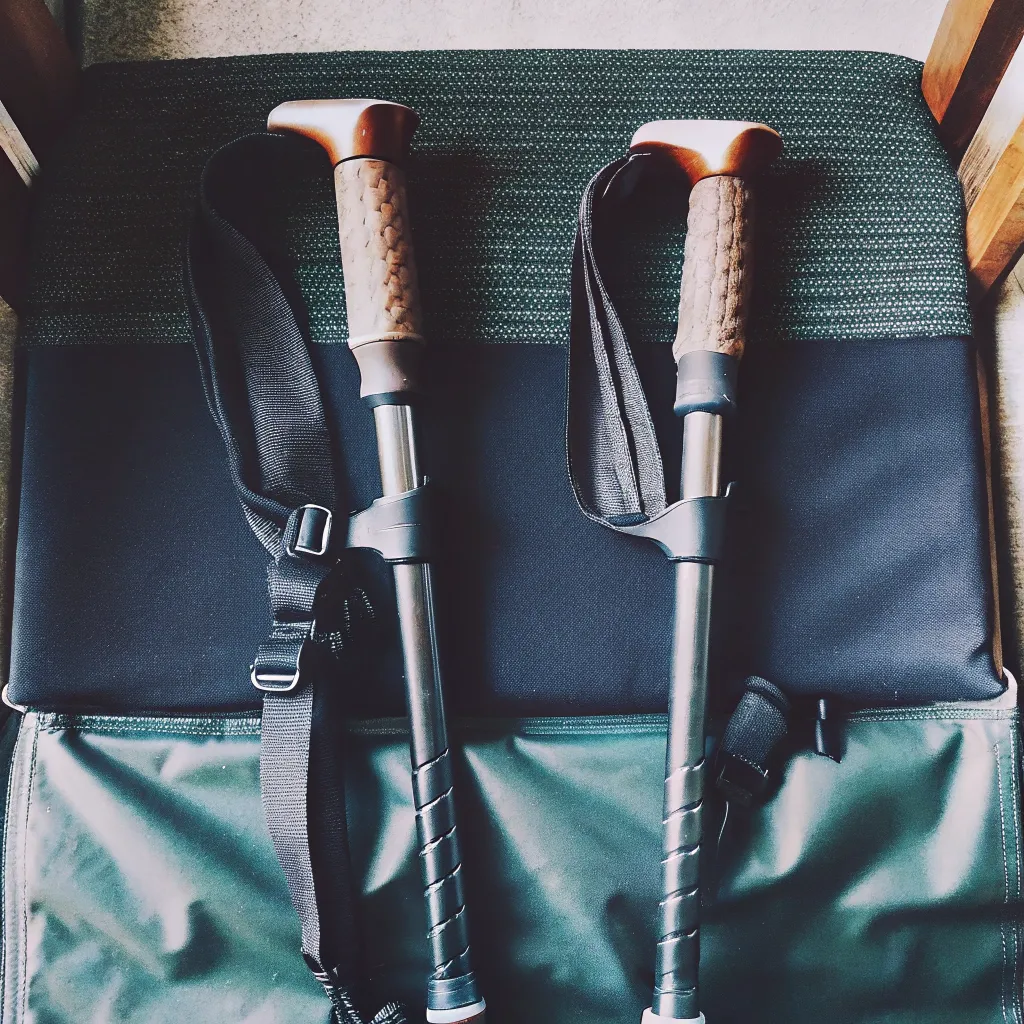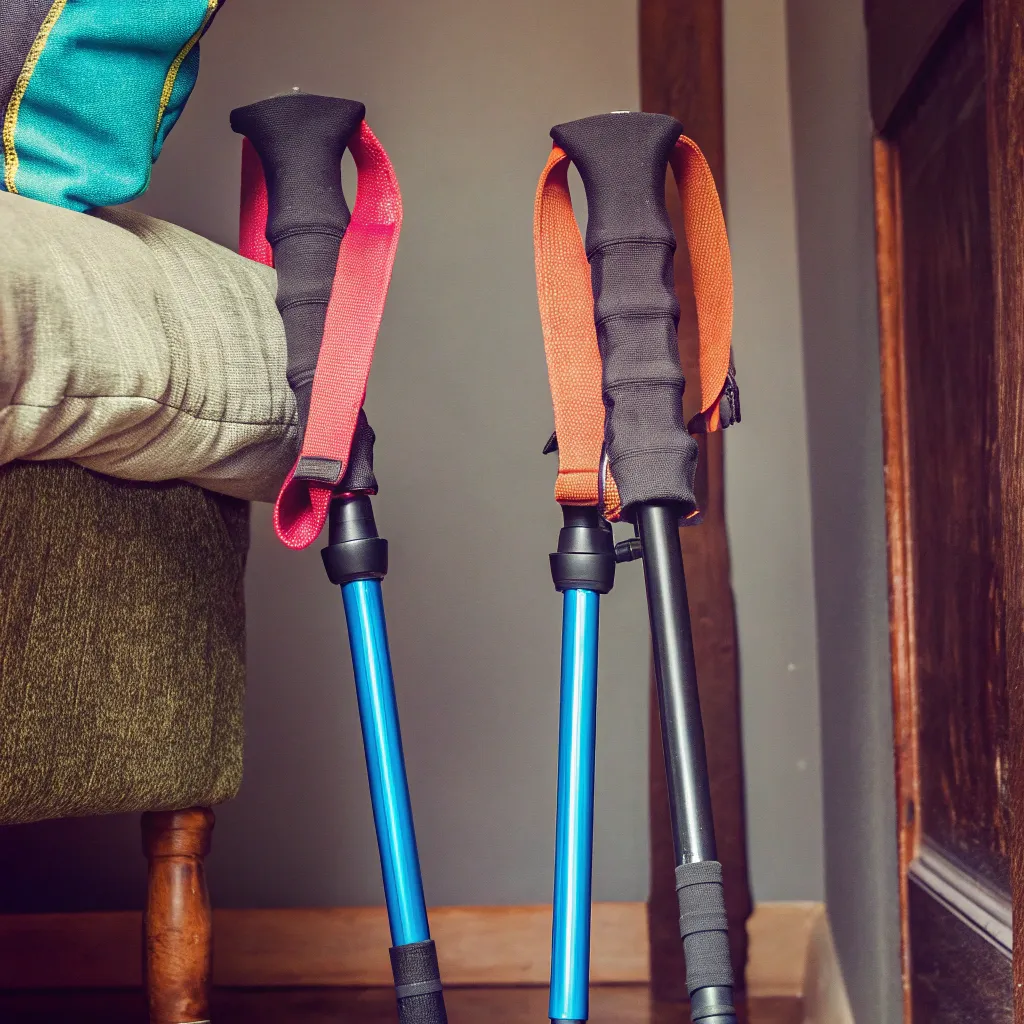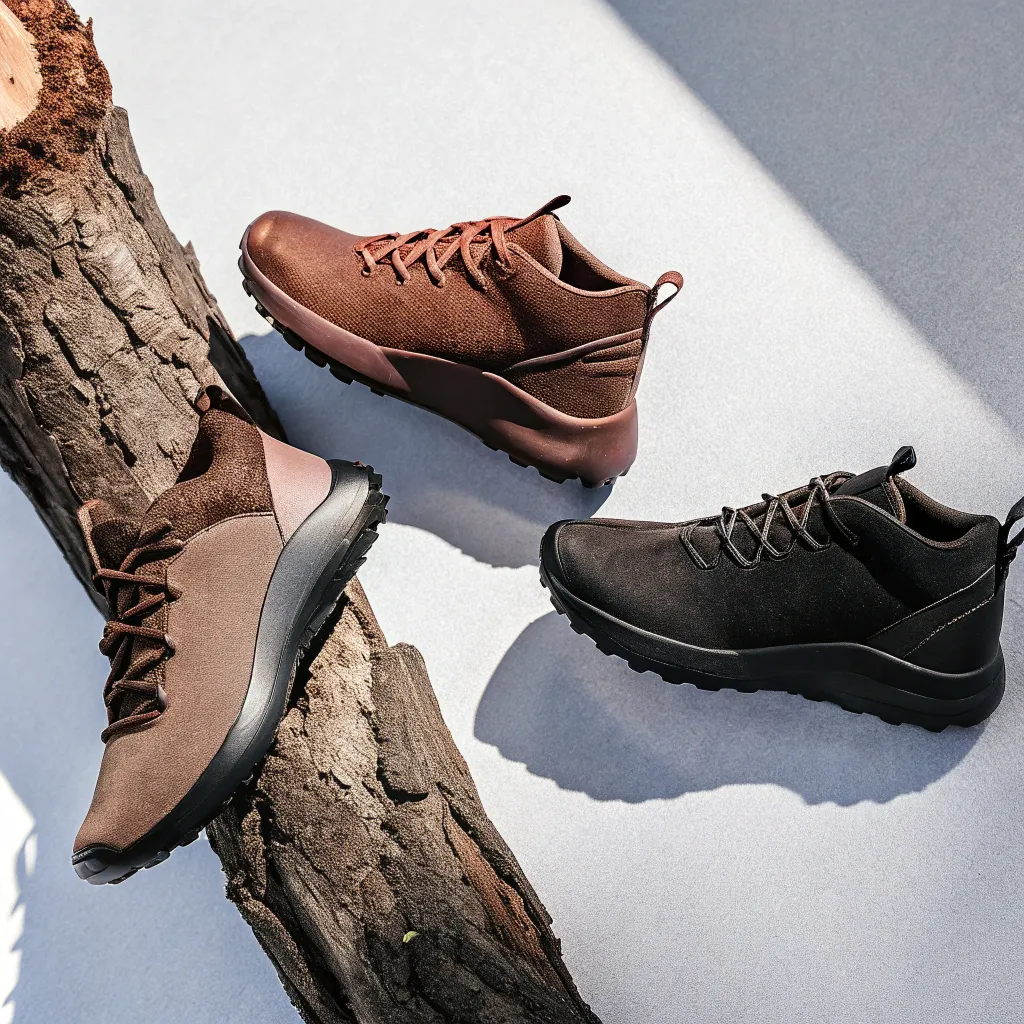Finding the right trekking poles can transform your hiking experience, whether you're tackling rocky mountain trails or gentle forest paths. After testing dozens of models across varied landscapes, I've compiled this comprehensive guide to help you find your perfect hiking companion. The right poles provide stability, reduce joint strain, and can even make the difference between an enjoyable adventure and a painful ordeal.
What Makes a Great Trekking Pole?
Before diving into specific recommendations, let's understand what separates exceptional trekking poles from mediocre ones. Having used everything from budget aluminum sticks to premium carbon fiber models, I've learned that several key factors determine performance across different terrains.
Material Matters: Aluminum vs. Carbon Fiber
The debate between aluminum and carbon fiber poles continues to divide hikers. Each material offers distinct advantages depending on your priorities:

Carbon Fiber Poles:
- Significantly lighter (typically 15-20% less weight than aluminum)
- Better shock absorption properties
- Minimal vibration transfer to hands and wrists
- Less prone to causing hand fatigue on long treks
- Typically more expensive
- Can catastrophically fail (snap) under extreme stress
Aluminum Poles:
- More durable against impacts and bending
- Usually bend rather than break under extreme pressure
- Generally more affordable
- Slightly heavier
- Transfer more vibration to hands
According to a 2023 survey by Hiking Magazine, 62% of serious hikers prefer carbon fiber for multi-day treks, while 71% of occasional hikers opt for aluminum due to cost considerations and durability.
Locking Mechanisms: Reliability When It Counts
Nothing's worse than a pole that collapses mid-stride on a steep descent. The three main locking systems each have distinct advantages:
Lever (External) Locks:
- Fastest adjustment in the field
- Visible confirmation they're secured
- Can sometimes require readjustment
- Work well in most conditions including cold weather
Twist (Internal) Locks:
- Sleeker appearance
- No external parts to catch on vegetation
- Can be frustrating to adjust with gloves
- May loosen during use if not properly tightened
Push-Button Locks:
- Simple, foolproof operation
- Limited adjustment options
- Lightweight design
- Less common on premium poles
I've found lever locks to be the most reliable for serious hiking, especially in winter conditions when wearing gloves. The Black Diamond Alpine Carbon Cork poles use a particularly trustworthy lever system that hasn't failed me even on rough descents in the Cascades.
Grip Materials: Your Hand-Pole Interface
The grip material affects comfort during long hikes more than most people realize:
Cork Grips:
- Conform to hand shape over time
- Absorb sweat without becoming slippery
- Comfortable in hot weather
- Natural antimicrobial properties
- Premium feel and typically higher cost
EVA Foam Grips:
- Soft and cushioned
- Lightweight
- Good moisture absorption
- Less durable than cork
- More affordable
Rubber Grips:
- Excellent insulation in cold conditions
- Doesn't absorb moisture
- Can cause blisters in hot weather
- Most durable option
For year-round hiking, cork grips typically provide the best balance of comfort and performance, though they command a premium price.
Top Trekking Poles for 2025
After extensive testing across diverse terrains from the muddy Pacific Northwest trails to the rocky paths of the Southwest, here are my top recommendations for different needs and budgets.
Best Overall: Black Diamond Alpine Carbon Cork
Price: $200
The Black Diamond Alpine Carbon Cork poles have earned their reputation as the gold standard for serious hikers. I've used these poles for over 500 miles of hiking across everything from desert slickrock to snow-covered mountain passes.
Why they excel:
- Perfect balance of weight (17 oz per pair) and durability
- 100% carbon fiber construction absorbs shock effectively
- Premium cork grips that mold to your hands over time
- Reliable FlickLock Pro lever locks that never slip
- Versatile carbide tips with interchangeable rubber tips included
- Extended foam grip below cork handle for quick terrain adjustments
- Four-season functionality with snow baskets available
The only significant drawback is the price, but considering these poles can last 5+ years of heavy use, they represent good value for serious hikers. During a particularly challenging descent in Zion National Park last month, these poles provided confidence-inspiring stability on loose scree that would have been treacherous without them.
Best Budget Option: KINGGEAR Nordic Walking Stick TP1
Price: $39.99
If you're just getting started with trekking poles or have a limited budget, the KINGGEAR TP1 poles offer surprising quality at an affordable price point. I initially bought these as backup poles but found myself using them regularly on day hikes.
Why they're worth considering:
- Remarkably lightweight for aluminum poles (18.5 oz pair)
- Comfortable anti-sweat EVA foam grips
- Quick-adjust lever locks that work reliably
- Retractable design for easy packing
- Includes multiple tip options and baskets
- Impressive durability for the price point
Customer reviews consistently mention these poles outperform their price category. As Amazon reviewer Ismael noted, "All you would want in hiking poles!" While they lack the refined feel of premium options, they provide excellent value for casual hikers or those on a budget.
Best for Winter & Rough Terrain: Black Diamond Alpine Carbon Cork
Price: $200
For challenging conditions including winter hiking, off-trail scrambling, and rough terrain, the Black Diamond Alpine Carbon Cork poles again take the top spot. Their versatility across conditions is unmatched.
Why they excel in tough conditions:
- Four-season functionality with interchangeable baskets
- Exceptional stability on uneven surfaces
- Carbon fiber construction provides crucial vibration dampening
- Extended grip area allows quick hand position changes on varied terrain
- Carbide tips provide excellent traction on ice and rock
During a winter ascent of Mount Hood, these poles provided crucial stability on icy sections and easily adapted to different snow conditions by switching baskets. The extended foam grip below the main handle proved invaluable when traversing steep slopes.
Best Lightweight Option: Foxelli Carbon Fiber Trekking Poles
Price: $59.99
For ultralight enthusiasts or those who prioritize minimal weight, the Foxelli Carbon Fiber poles offer an impressive weight-to-strength ratio at a surprisingly affordable price.
Why weight-conscious hikers love them:
- Incredibly lightweight at just 15.2 oz per pair
- 100% carbon fiber construction
- Cork grips with extended EVA foam grip area
- Quick-adjust lever locks
- All-terrain accessories included (mud baskets, snow baskets, rubber tips)
- Collapsible to 24 inches for easy packing
These poles have gained popularity among thru-hikers and ultralight backpackers who count every ounce. While not quite as durable as the Black Diamond offerings, they represent an excellent value for weight-conscious hikers. I've used these on several 15+ mile days and appreciated the reduced fatigue from the lighter swing weight.
Best for Versatility: Montem Ultra Strong Trekking Poles
Price: $69.99
For hikers who want one set of poles to handle everything from desert hikes to snowy mountain passes, the Montem Ultra Strong poles offer exceptional versatility at a reasonable price point.
Why they're great all-rounders:
- Durable aluminum construction
- Comfortable EVA foam grips
- Reliable lever locks
- Includes tips for different seasons and terrains
- Extended grip area for varied hand positions
- Excellent balance of weight (19.2 oz pair) and durability
As noted by VeryWellFit's review, these are "our top pick for all-terrain hiking" thanks to their adaptability across conditions. I've found them particularly useful for trips where I might encounter multiple terrain types in a single day.
How to Choose the Right Trekking Poles for Your Needs?
With so many options available, selecting the perfect poles can feel overwhelming. Consider these factors to narrow down your choices:
Terrain Considerations
The type of terrain you typically hike should heavily influence your choice:
For well-maintained trails:
- Lighter poles with focus on comfort
- Less emphasis needed on durability
- Standard baskets usually sufficient
For rough, rocky terrain:
- Prioritize durability and shock absorption
- Consider poles with extended grip areas
- Carbide tips essential
For snow and winter conditions:
- Reliable locking mechanisms that work with gloves
- Poles that accept snow baskets
- Consider aluminum for extreme cold (carbon fiber can become brittle)
Height and Adjustment Range
Proper pole length is crucial for comfort and effectiveness:
- For level terrain: Poles should create a 90-degree angle at your elbow when gripping the handle
- For uphill: Shorten poles by 5-10 cm
- For downhill: Lengthen poles by 5-10 cm
Most adjustable poles accommodate users between 5'0" and 6'4", but check the specific adjustment range if you're particularly tall or short. I'm 6'2" and have occasionally maxed out the adjustment range on some models during steep descents.
Weight Considerations
How much weight matters depends on your hiking style:
- For day hikers: Weight is less critical; prioritize comfort and features
- For backpackers: Consider mid-range weight options with good durability
- For ultralight hikers: Every ounce counts; carbon fiber becomes worth the investment
Remember that the difference between the lightest and heaviest poles in this review is only about 4 ounces per pair – noticeable on long hikes but not significant for casual use.
How Do Trekking Poles Benefit Hikers?
If you're still wondering whether trekking poles are worth the investment, consider these evidence-backed benefits:
Reduced Impact on Joints
Research published in the Journal of Sports Sciences found that trekking poles can reduce impact forces on knees by up to 25% during descents. This is particularly valuable for hikers with existing joint issues or those on multi-day treks where cumulative impact can lead to soreness and injury.
Improved Stability and Balance
A study from the Human Performance Laboratory at Northern Michigan University demonstrated that hikers using poles maintained better balance on uneven terrain and were less likely to experience falls. I've personally found this benefit enormous when crossing streams or navigating slippery conditions.
Enhanced Endurance
By engaging your upper body in the hiking motion, poles distribute workload more evenly across muscle groups. This can reduce fatigue in the legs and improve overall endurance. On a recent 18-mile day in the Olympic Mountains, my trekking poles made the final miles significantly more manageable by sharing the work between arms and legs.
Additional Uses
Beyond their primary purpose, trekking poles serve multiple functions:
- Tent pole replacements for some ultralight shelters
- Checking water depth at stream crossings
- Clearing spider webs from the trail (someone has to go first!)
- Deterring wildlife in some situations
How Should I Use Trekking Poles Correctly?
Even the best trekking poles won't help much if used improperly. Here are some tips for maximizing their effectiveness:
Basic Technique
- Adjust pole length appropriately for the terrain
- Use the wrist straps correctly by inserting your hand up through the bottom of the strap
- Plant poles with each step in an alternating pattern (left pole with right foot)
- Allow the poles to bear weight naturally rather than placing them too far forward
Terrain-Specific Adjustments
For uphill sections:
- Shorten poles slightly
- Plant poles ahead of you and push down as you step up
- Focus on using poles to assist your climbing motion
For downhill sections:
- Lengthen poles slightly
- Plant poles ahead of your steps to brake momentum
- Allow poles to take some of your weight to reduce impact
For side-hilling (traversing):
- Adjust the uphill pole shorter and downhill pole longer
- Use the uphill pole for balance and the downhill pole for support
FAQ: Common Questions About Trekking Poles
Are two trekking poles better than one?
While some hikers prefer using a single pole, research suggests that two poles provide more balanced support and more effectively reduce impact forces on joints. Two poles also engage both arms equally, preventing muscle imbalances over time. That said, in some technical terrain where you need a free hand, a single pole can be preferable.
Last summer while hiking in the Grand Canyon, I experimented with both approaches and found that two poles significantly reduced knee pain during the steep climb out, while a single pole felt insufficient for the same terrain.
How long should trekking poles last?
With proper care, quality trekking poles should last for many years of regular use:
- Premium carbon fiber poles: 5-7+ years of regular use
- Quality aluminum poles: 7-10+ years
- Budget poles: 2-4 years
The most common failure points are the locking mechanisms and tips, both of which can often be repaired or replaced, extending the life of your poles considerably.
Can I take trekking poles on airplanes?
Trekking poles must be checked when flying – they cannot be carried on. To protect them during transit:
- Collapse them fully
- Secure any loose parts
- Consider a padded case or wrap them in clothing within your luggage
- Some hikers remove the tips before flying to prevent damage
I learned this lesson the hard way when airport security confiscated my favorite poles a few years ago because I attempted to carry them on.
Maintenance Tips for Extending Pole Life
With proper care, quality trekking poles can last for many years. Follow these simple maintenance practices:
- Rinse poles after use in sandy, muddy, or salty conditions
- Dry completely before storing for extended periods
- Periodically check and tighten locking mechanisms
- Replace worn tips (most manufacturers sell replacement tips)
- For twist-lock poles, disassemble occasionally to clean internal components
- Store in a dry place away from extreme temperatures
I've had my Black Diamond poles for over five years, and with regular maintenance, they're still performing like new despite hundreds of miles of use.
Final Thoughts: Investing in the Right Poles
After testing dozens of models across various price points, I've found that trekking poles are one piece of gear where quality truly matters. While budget options like the KINGGEAR poles can serve casual hikers well, those who regularly tackle challenging terrain will benefit from investing in premium options like the Black Diamond Alpine Carbon Cork.
Consider your typical hiking environment, frequency of use, and budget when making your selection. Remember that even the most expensive poles cost less than a visit to the orthopedist for a hiking-related injury – making them a worthwhile investment in both enjoyment and safety on the trail.
Whether you're a weekend warrior exploring local trails or planning a thru-hike of the Appalachian Trail, the right trekking poles can enhance your hiking experience in countless ways. Choose wisely, use properly, and enjoy the added stability, reduced joint strain, and improved hiking efficiency they provide.
This article was last updated on December 15, 2024, based on the latest product testing and market research.






